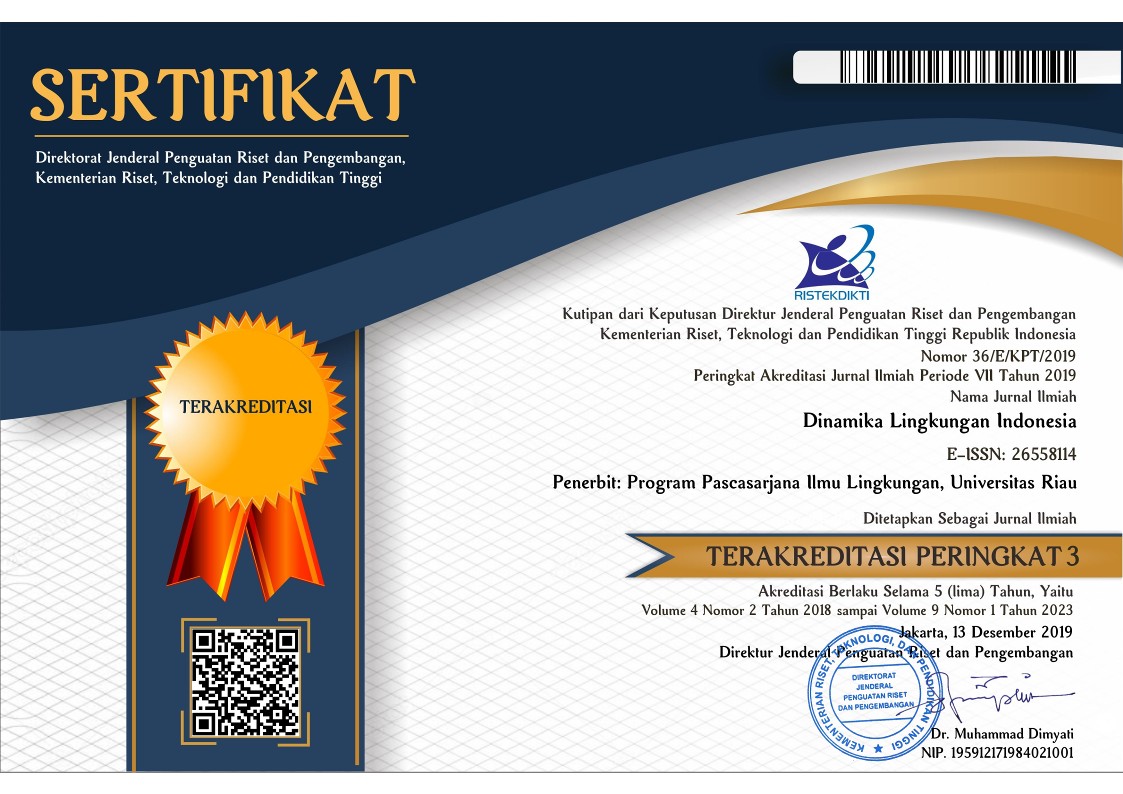Kontribusi Produksi Cellular Lightweight Concrete Serat Limbah Pelepah Kelapa Ssawit Terhadap Emisi CO2
Abstract
The vast palm oil plantations in Riau province which are 2,430,500 hectares (BPS Indonesia, 2017) have great potential as a provider of CPO (Crude Palm Oil) and other by-products and include waste. The midrib is always lowered along with the decrease in oil palm fruit bunches at harvest. Handling of waste from the midrib is only by stacking it in the field and letting it dry and self-destruct. Oil palm midribs are still a problem today because they can affect the global climate with greenhouse gas emissions. Carbon emissions can still be minimized by utilizing oil palm midribs. This study aims to measure the reduction of CO2 emissions as an added ingredient in the production of fiber CLC. Presentation of research results using descriptive methods. Research conducted in laboratories with an experimental approach is quantitative. The findings of this study are that the use of oil palm fronds as an added ingredient in producing CLC of solar and electric fuel fibers by 1 m3 can reduce CO2 emissions. The conclusion of this study is that CO2 emissions that can be reduced in the manufacture of 1 m3 of fiber CLC using diesel fuel is 111,582 tons/year and when using an electrically driven engine the CO2 emissions that can be reduced are 120.887 tons/year.
Keywords
Full Text:
PDFReferences
Badan Pusat Statistik Provinsi Riau. (2016). Provinsi Riau Dalam Angka 2016. Pekanbaru.
Calkins, M. (2009). Materials for Sustainable Sites. John Wiley & Sons. Inc. Canada.
IPCC. (2006). Pedoman IPCC Untuk Inventarisasi Nasional Gas Rumah Kaca; Nasional Greenhouse Gas Inventories Program. Jepang.
Lukito, M. dan Rohmatiah, A. (2013). Estimasi Biomassa dan Karbon Tanaman Jati Umur 5 Tahun (Kasus Kawasan Hutan Tanaman Jati Unggul Nusantara (JUN) Desa Krowe, Kecamatan Lembeyen Kabupaten Magetan). Jurnal Agri-tek, 14 (1), 1-23.
Mubekti. (2014). Carbon Estimation in Palm Oil Industry. Jurnal Teknologi Lingkungan, 15 (1), 35-42.
Puslitbangkim (Pusat Penelitian dan Pengembangan Pemukiman) Departemen Pekerjaan Umum. (2002). Keputusan Menteri Pemukiman dan Prasarana Wilayah Republik Indonesia No. 403/KPTS/M/2002 Tentang Pedoman Teknis Pembangunan Rumah Sederhana Sehat (Rs. Sehat). Bandung.
Saharjo, B.H., Putra, E.I. and Putra, R.M. (2013). Pendugaan Emisi Karbon (CO2) Akibat Kebakaran Hutan dan Lahan pada Berbagai Tipe Penutupan Lahan di Propinsi Riau Tahun 2000-2009. Jurnal Silvikultur Tropika, 4 (3), 130-135.
Siswoko, E., Mulyadi, A., Thamrin dan Bahruddin. (2017). Estimating Carbon Stock of Oil Palm Trunks Waste as Replanting Management in Riau Province. Jurnal Ilmu Lingkungan, 11 (2), 154-163.
Sofaniadi, S., Purwanto, P. and Riyanto, B. (2018). Evaluation of Greenhouse Gas Emission from Transportation Sector in Semarang, Indonesia. “Pollution Research” EM International, 37 (3), 658-662.
Wirosoedarmo, R., Haji, A.T.S. and Gustinasari, K. (2017). Effect of Conversion of Agriculture Land on Air Pollution Emission of CO2 (The Case Study in The Settlement Sawojajar, Malang, East Java, Indonesia. EM International “Pollution Research”, 36 (4), 729-736.
Zainuri, Yanti, G. and Megasari, S.W. (2017). Batako Quality Optimization with Addition of Palm Oil Stem Fiber from Kampar District and Dumai City. International Conference on Environment and Technology (IC-Tech) 2017. IOP Conference Series: Earth and Environmental Science, 97 (1), 1-6. 26-27 July 2017, Pekanbaru, Indonesia. Published under licence by IOP Publishing Ltd. doi:10.1088/1755-1315/97/1/012018.
Zainuri, Zargustin, D., Yanti, G. and Megasari, S.W. (2019). Reduction of CO2 Emissions from Utilization of Palm Oil Midrib Waste in Fiber Brick Production. Jurnal Teknologi Lingkungan, 20 (1), 37-44.
Zainuri, Sujianto, Ahmad, A., and Feliatra (2019). Comparison of Cellular Lightweight Concrete With Addition of Palm Oil Midribs. International Journal of Civil Engineering and Technology (IJCIET), 10 (04), 1211-1218.
DOI: http://dx.doi.org/10.31258/dli.6.2.p.104-109
Refbacks
- There are currently no refbacks.





